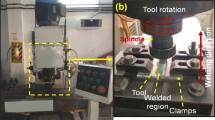Abstract
Hadfield steels are materials with high wear resistance used in the construction of parts that work in abrasive friction, high pressures and mechanical shock conditions. Four experimental samples, obtained from commercial T105Mn120 steel, were subjected to isothermal dynamic mechanical analysis in strain sweep mode (DMA-SS), by means of a dual cantilever specimen holder, at two temperatures, − 40 and + 50°C, with two SS frequencies: 0.5 and 16.66 Hz. These temperatures and frequencies correspond to the extreme conditions encountered during railway exploitation, being caused by environmental temperature or wagon wheel speed, respectively. The samples were work hardened through dynamic loadings and present different surface profilometries. Wear tests were carried out, and mean friction coefficient was determined based on friction torque measurements. Prior and after wear test, surface morphology was analyzed using scanning electron microscopy coupled with energy dispersive spectroscopy and micro-hardness determinations. The results indicate that the tested samples underwent work hardening through a wear mechanism that can explain the remarkable surface resistance of these executive elements of railway safety systems cast from Hadfield steel.








Similar content being viewed by others

References
H. Xue, W. Peng, L. Yu, R. Ge, D. Liu, W. Zhang and Y. Wang, Effect of Hardenability on Microstructure and Property of Low Alloy Abrasion-Resistant Steel, Mater. Sci. Eng. A, 2020, 793, p 139901.
M.A. Moore, Abrasive Wear, ed. by D.A. Rigney. Fundamentals of Friction and Wear of Materials (ASM, Pittsburgh, 1981), pp 73–118.
M. Lindroos, K. Valtonen, A. Kemppainen, A. Laukkanen, K. Holmberg and V. Kuokkala, Wear Behavior and Work Hardening of High Strength Steels in High Stress Abrasion, Wear, 2015, 322–323, p 32–40.
S. Ge, Q. Wang and J. Wang, The Impact Wear-Resistance Enhancement Mechanism of Medium Manganese Steel and its Applications in Mining Machines, Wear, 2017, 376–377, p 1097–1104.
P.C. Machado, J.I. Pereira, J.J. Penagos, T. Yonamine and A. Sinatora, The Effect of in-Service Work Hardening and Crystallographic Orientation on the Micro-Scratch Wear of Hadfield Steel, Wear, 2017, 376–377, p 1064–1073.
V.G. Efremenko, K. Shimizu, T. Noguchi, A.V. Efremenko and Yu.G. Chabak, Impact–Abrasive–Corrosion Wear of Fe-Based Alloys: Influence of Microstructure and Chemical Composition Upon Wear Resistance, Wear, 2013, 305, p 155–165.
Z. Guanghong, D. Hongyan, Z. Yue and L. Nianlian, Corrosion–Erosion Wear Behaviors of 13Cr24Mn0.44N Stainless Steel in Saline-Sand Slurry, Tribol. Int., 2010, 43, p 891–896.
D. Hou-fu, C. Fang-ming and D. Xiao-dong, Effect of Component and Microstructure on Impact Wear Property and Mechanism of Steels in Corrosive Condition, J. Mater. Sci. Eng. A., 2006, 421, p 161–167.
V. Bulbuc, B. Pricop, F. Maxim, M. Popa, N. Cimpoeşu and L.-G. Bujoreanu, Influence of Dynamic Three Point Bending on the Work Hardening Capacity of T105Mn120 Manganese Steel, J. Mater. Eng. Perform., 2018, 27, p 6127–6134.
V. Bulbuc, B. Pricop, F. Maxim, M. Popa, N. Cimpoeşu and L.-G. Bujoreanu, Variation of Damping Behaviour of T105Mn120 Castings, Used for Railway Safety Systems, as an Effect of Extreme Loading Conditions, Mater. Today: Proc., 2019, 19, p 949–955.
V. Paleu, C. Cîrlan Paleu, B. Istrate, S. Bhaumik, C. Munteanu, Friction and wear resistance of Al2O3 40TiO2 (AMDRY 6250) coating of a pump shaft sleeve bearing, In: IOP Conference Series: Materials Science and Engineering, 2020, 724(1), 012064.
M. Sedlaček, P. Gregorčič and B. Podgornik, Use of the Roughness Parameters Ssk and Sku to Control Friction—A Method for Designing Surface Texturing, Tribol. Trans., 2017, 60(2), p 260–266.
I. Gutierrez-Urrutia and D. Raabe, Dislocation and Twin Substructure Evolution During Strain Hardening of an Fe-22wt%Mn-0.6wt.%C TWIP Steel Observed by Electron Channeling Contrast Imaging, Acta Mater., 2011, 59(16), p 6449–6462.
J. Rendon and M. Olsson, Abrasive Wear Resistance of Some Commercial Abrasion Resistant, Steels Evaluated by Laboratory Test Methods, Wear, 2009, 267, p 2055–2061.
S. Ilo, A. Tomala and E. Badisch, Oxidative Wear Kinetics in Unlubricated Steel Sliding Contact, Tribol. Int., 2011, 44, p 1208–1215.
R. Tyagi, S.K. Nath and S. Ray, Effect of Martensite Content on Friction and Oxidative Wear Behavior of 0.42 Pct Carbon Dual-Phase Steel, Metall. Mater. Trans. A, 2002, 33, p 3479–3488.
M. Lou, D.R. White, A. Banerji and A.T. Alpas, Dry and Lubricated Friction Behaviour of Thermal Spray Low Carbon Steel Coatings: Effect of Oxidational Wear, Wear, 2019, 102921, p 432–433.
B.D. Shanina, A.I. Tyshchenko, I.N. Glavatskyy, V.V. Runov, Y.N. Petrov, H. Berns and V.G. Gavriljuk, Chemical Nano-Scale Homogeneity of Austenitic CrMnCN Steels in Relation to Electronic and Magnetic Properties, J. Mater. Sci., 2011, 46, p 7725–7736.
D. Dunne, Shape memory in ferrous alloys, Diffusionless Transformations High Strength Steels Modelling and Advanced Analytical Techniques, Vol 2, E. Pereloma, D.V. Edmonds Ed., Woodhead Publishing, Cambridge, 2012, p 83–125
M. Kirchgaßner, E. Badisch and F. Franek, Behavior of Iron-Based Hard Facing Alloys Under Abrasion and Impact, Wear, 2008, 265, p 772–777.
M. Szala, L. Łatka, M. Walczak and M. Winnicki, Comparative Study on the Cavitation Erosion and SlidingWear of Cold-Sprayed Al/Al2O3 and Cu/Al2O3 Coatings, and Stainless Steel Aluminium Alloy, Copper and Brass, Metals, 2020, 10, p 856.
O.I. Balyts’kyi, V.O. Kolesnikov and P. Kawiak, Triboengineering Properties of Austenitic Manganese Steels and Cast Irons Under the Conditions of Sliding Friction, Mater. Sci., 2005, 41(5), p 624–630.
C. Carboga, B. Aktas and B. Kurt, Dry Sliding Wear Behavior of Boron-Doped 205 Manganese Steels, JMEPEG, 2020, 29, p 3120–3126.
K. Drozd, M. Walczak, M. Szala and K. Gancarczyk, Tribological Behavior of AlCrSiN-Coated Tool Steel K340 Versus Popular Tool Steel Grades, Materials, 2020, 13, p 4895.
Author information
Authors and Affiliations
Corresponding author
Additional information
Publisher's Note
Springer Nature remains neutral with regard to jurisdictional claims in published maps and institutional affiliations.
Rights and permissions
About this article
Cite this article
Bulbuc, V., Paleu, V., Pricop, B. et al. Effects of Dynamic Loading under Extreme Conditions on Wear Resistance of T105Mn120 Castings for Railway Safety Systems. J. of Materi Eng and Perform 30, 7128–7137 (2021). https://doi.org/10.1007/s11665-021-05837-7
Received:
Revised:
Accepted:
Published:
Issue Date:
DOI: https://doi.org/10.1007/s11665-021-05837-7



